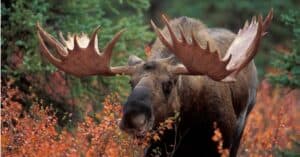There are certain words you never want to hear from your veterinarian. A cancer diagnosis is one of them. Whether your kitty has been recently diagnosed or you want to understand what to look out for, this is your resource. Learn more about cancer in cats, including causes, symptoms, and treatment options.
Causes of Cancer in Cats
For cats, the causes of cancer are quite similar to the causes for humans. For example, if a cat is exposed to tobacco smoke, they are more likely to develop cancer. The same is true for other risk factors, including lack of physical activity and even prolonged exposure to sunlight. Like in humans, a poor diet contributes to cancer development. Cats are obligate carnivores, which means they need meat along with other nutrients, including vitamins and minerals. They need high-quality food.

There are many causes of cancer, including a poor diet.
©PHOTOCREO Michal Bednarek/Shutterstock.com
If you have a female cat, the age she was spayed may determine whether she develops cancer. The American College of Veterinary Surgeons confirms that cats should be spayed before they turn six months old to reduce the risk of mammary tumors, which are most often malignant. Causes also include feline leukemia virus (FeLV), feline immunodeficiency virus (FIV), and breed. Aside from that, vaccinations, injections, device implantation, and even a healed fracture could cause cancer.
Types of Cancer in Cats
Squamous Cell Carcinoma (SSC)
This is a fast-growing skin tumor. It’s the most common of its kind in cats.
Fibrosarcoma
This is a slow-spreading cancer that affects the soft tissue. Though it’s slow to spread, it can be quite aggressive locally.
Lymphoma
This type of cancer is the most common seen in cats and affects the lymph nodes, kidneys, and GI tract.
Mastocytoma
These are mast cell tumors that may develop in either the spleen or on the skin. They start in the bone marrow and make their way around a cat’s body.
Osteosarcoma
This type of cancer is painful and attacks the bones. It’s aggressive.
Melanoma
Melanomas may appear in different parts of the body, even around the face. They are raised masses that sometimes bleed.
Leiomyosarcoma
This type of cancer is rare. It’s painful and affects the soft tissue in the intestines and stomach.
Mammary Tumors
These tumors form around a cat’s teat. These is an aggressive type of cancer that tends to spread to the lungs and lymph nodes.
Myeloproliferative Neoplasm
This is a blood cancer that starts in the bone marrow.
Transitional Cell Carcinoma (TCC)
This locally aggressive cancer originates in the bladder.
Hemangiosarcoma
This is a fast-growing cancer that starts out in the blood vessel cells. In some cases, this type of cancer causes internal bleeding.
Ceruminous Gland Adenocarcinoma
This cancer often starts right around the ear canal, specifically in a cat’s sweat glands.
Symptoms of Cancer in Cats

The exact symptoms a cat experiences depends on the type of cancer attacking their body.
©iStock.com/krblokhin
The symptoms a cat experiences with cancer differ depending on the type of cancer they are diagnosed with. Some of those symptoms may include the following:
- Vomiting
- Diarrhea
- Lethargy
- Hard time eating
- Bad breath
- Changes in weight
- Difficulty breathing
- Bloating
- Bumps and lumps
- Blood in urine/feces
- Difficulty in the litter box
Cancer Diagnosis in Cats
A-Z-Animals spoke with Dr. Colleen Wallace, a cat-only vet at Cozy Cat Veterinary Hospital in Raleigh, NC, who explained that any unusual symptoms (like those listed above) require a veterinary visit for examination. A raised bump, for example, may be a sign of skin cancer. But it may also be a benign fibroblastic tumor, which grows exceptionally slowly and doesn’t spread.
For a cancer diagnosis, your vet will first review your cat’s medical history. They will ask you to explain the symptoms you’ve noticed (which you should track at home to ensure accuracy). Then, they will move forward with a thorough exam. They may also test your cat’s blood, take x-rays, perform an ultrasound, endoscopy, CT, or MRI.
Although imaging tools help your vet locate cancer, they do not identify the type of cancer present. Therefore, your vet may collect a small sample from the tumor for further examination. If this requires surgery, your cat needs to be cleared for sedation or anesthesia. For cats that are not cleared for sedation or anesthesia, further testing is not an option.
Treatment Options for Cancer in Cats
The type of cancer present determines the method of treatment. In some cases, a cat can make a complete recovery. But it doesn’t just depend on the cancer type. Any pre-existing health issues, how much the cancer has developed, how big the tumor is, and where it’s located are all factors that determine treatment options.
Your veterinarian will develop a plan and explain your options to you. They may choose to move forward with surgery, chemotherapy, radiation, immunotherapy, and/or photodynamic therapy. Typically, veterinarians opt for a combination of these available treatments to give your cat the best fighting chance. When kitties are not strong enough to handle treatment, they are offered palliative care, which offers them relief from the cancer symptoms.
Thank you for reading! Have some feedback for us? Contact the AZ Animals editorial team.








